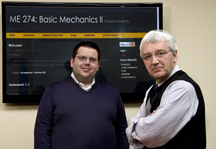
Jeffrey Rhoads, left, and Charles Krousgrill are using a new teaching approach for large classes that allows students to interact with each other and faculty online while accessing hundreds of instructional videos and animations. Krousgrill, a professor of mechanical engineering, pioneered the system, called the Purdue Mechanics Freeform Classroom. (Credit: Purdue University photo/Mark Simons)
Purdue University researchers who developed a new approach to more effectively teach large numbers of engineering students are recommending that the approach be considered for adoption by universities globally.
The system, called the Purdue Mechanics Freeform Classroom, allows students to interact with each other and faculty online while accessing hundreds of instructional videos and animations. It was pioneered by Charles Krousgrill, a professor of mechanical engineering, and has been used for more than two years in two mechanical engineering core courses with hundreds of students enrolled annually.
“Data analysis shows that the students are really engaging our materials, and it is having a marked effect on student performance,” said Krousgrill, who is working with Jeffrey Rhoads an associate professor of mechanical engineering; Eric Nauman, a professor of mechanical engineering; and Beth Holloway, assistant dean for undergraduate education in Purdue’s College of Engineering. “We’d really like to see this expand beyond the borders of Purdue and are working now to make it happen.”
The teaching approach addresses the challenges of educating large core-engineering classes, which have seen increasing student enrollment in recent years, and has significantly reduced the number of students who receive a grade of D; or drop, fail or withdraw from the courses (DFW).
The new approach is detailed in a research paper being presented during the American Society for Engineering Education Annual Conference and Exposition in Indianapolis on June 15-18. The paper was authored by Rhoads, Krousgrill, Nauman and Holloway, who also is director of the Purdue Women in Engineering Program.
The system includes highly interactive course blogs and has been implemented for five semesters in Basic Mechanics I – an introductory course in statics and strength of materials – and seven semesters in Basic Mechanics II – an introductory course in dynamics and mechanical vibration.
New findings indicate that the rate of students receiving a D, fail or withdraw from courses has been substantially reduced since its implementation. The DFW rate in Basic Mechanics I was 32 percent in the fall semester of 2008 and 18 percent in the fall semester of 2013. Likewise, the DFW rate in Basic Mechanics II was 21 percent in the spring semester of 2009 and 11 percent in the spring semester of 2013.
“With continued development and expansion we hope that the Purdue Mechanics Freeform Classroom can be adopted at colleges and universities across the globe, rendering a positive and uniform mechanics education experience for all,” Rhoads said.
A key driving force to developing the system was the need to educate more students, while also providing deeper knowledge.
“When you have more than 100 students in a classroom, you need to find a creative solution; you no longer have direct access to students,” Krousgrill said. “Anecdotally speaking, typical lecture attendance appears to have actually increased with the implementation of the Purdue Mechanics Freeform Classroom to approximately 85-95 percent, compared to the approximately 70 percent seen prior to implementation. Interestingly, instructors commonly report that the quality of in-class discussions and student engagement has increased as well.”
The approach also might be used for any large STEM-related courses.
One obstacle, however, to its widespread adoption is resistance from faculty.
“Despite the seemingly positive impact on student performance and outcomes, there remain key challenges for broader implementation, most of which are strongly tied to faculty buy-in,” Nauman said.
Source: Purdue University.
Published on 11th June 2014


